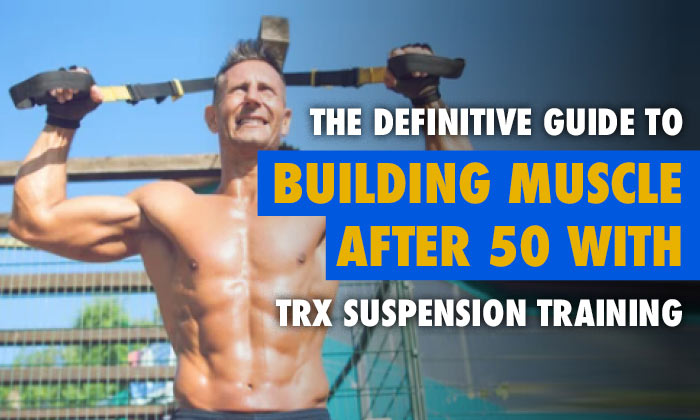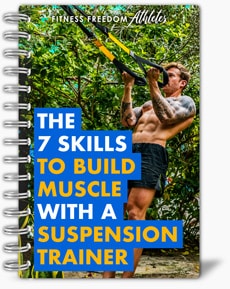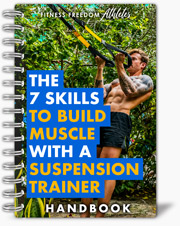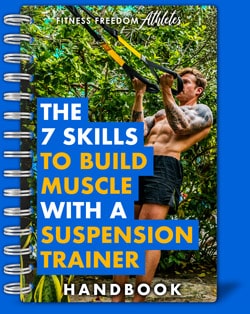
Do you believe that after 50, building muscle is either impossible or requires a gym full of weights? Let me tell you, both are BS.
When you’re older, you’re busier and have more life commitments. Sacrificing precious family and work time for a gym isn’t always possible…
But, by focusing on effective muscle-centric techniques with a TRX suspension trainer, a little nutrition optimisation, and the right mindset, you can build muscle and gain strength from the comfort of your own home.
This is the core of what I call Fitness Freedom: the confidence to shape your body and reach your fitness goals on your terms, without needing to rely on a gym or ‘diet fads’.
Building Lean Muscle Over 50 Process
In this guide, I’ll take you through the entire process of building lean muscle using a TRX suspension trainer, with a specific focus on muscle-centric technique, mind-muscle connection, and simple science-backed nutrition optimisation…
Three principles that have transformed the lives of over 8,000 busy professionals in the Fitness Freedom Athletes community–The majority of who, are over 50.
Ready? Let’s get into it…
Table Of Contents
1. The Benefits of Building Muscle After 50
If you’re over 50 and thinking about strength training, you’ve already got the right mindset. You just need direction for the right path. Regular muscle-building workouts are a powerful tool to improve your quality of life, increase your energy, and help you stay active and resilient as you age.
Why is Muscle Building Crucial After 50?
As you get past 30, your muscle mass starts to decline naturally in a process called sarcopenia, which accelerates the more age. This muscle loss can lead to reduced mobility, balance issues, decreased metabolism, and an even greater risk of falls. However consistent strength training can slow or even reverse this process.
Key Benefits of Building Muscle After 50
- Supports Bone Density: Strength training stimulates bone growth, increasing bone density and reducing the risk of osteoporosis and fractures.
- Improves Metabolism: Muscle tissue burns more calories than fat, even at rest. Imagine burning through fat as you watch Netflix! More muscle means a higher resting metabolic rate, which helps prevent weight gain and supports energy levels.
- Enhances Joint Health and Stability: Strong muscles provide stability to the joints, reducing strain on ligaments and tendons. Many people over 50 think exercise is aggravating their joints. In fact it’s because they are loading the joint and NOT the muscle when they exercise.
- Boosts Cardiovascular Health: Strength training supports heart health by lowering blood pressure and improving cholesterol levels.
- Improves Mental Health and Confidence: Exercise, particularly strength training, has been shown to reduce anxiety, improve mood, and enhance self-esteem. And when you combine it with your mind-muscle connection. It’s a powerful double whammy for body and mind.
When you start to see and feel the results, you’ll also gain renewed confidence in your body’s ability to stay strong, vibrant, and active, regardless of age.

Get Your FREE Copy Of My ‘7 Skills To Build Muscle With A Suspension Trainer Handbook!’
Downloaded 70,000+ times! Just tell me where to send it:
2. Why Choose TRX Suspension Training?
A TRX suspension trainer is a versatile and effective tool for building lean muscle at any age, but it’s particularly beneficial for those over 50 who want to train safely at home. Suspension training utilises your body weight as the load to create resistance in the exercises. And can be adjusted easily, making it suitable for all fitness levels.
Why TRX Works for Older Adults
- Joint-Friendly Movements: Unlike heavy weights, using a TRX suspension trainer to exercise provides low-impact resistance training. Which puts less stress on your joints. This reduces injury risk and supports joint health.
- Progressive Resistance: By simply changing your body’s angle, you can increase or decrease the intensity of any TRX exercise, allowing for gradual progression and constant challenge as you build strength.
- Full-Body Workouts: TRX exercises engage multiple muscle groups at once, helping you build functional strength that supports everyday activities, balance, and coordination.
- Portable and Convenient: A TRX can be used anywhere, giving you the flexibility to train at home, outdoors, or even while traveling—true Fitness Freedom.
With TRX suspension training, you can effectively work out on your terms because every exercise moulds to your unique biomechanics–safely, and without needing a lot of space or equipment.
3. Key Techniques for Effective TRX Muscle Building
To make the most out of your TRX workouts, it’s essential to understand the techniques that will help you build muscle effectively…
Movement-Centric vs. Muscle-Centric Techniques
Most people approach TRX or bodyweight training with a movement-centric technique, focusing on moving from point A to point B without isolating or engaging specific muscles.
It’s mindless movement. And while this keeps you active, it’s not the most effective way to build lean muscle… To do that you want to perform muscle-centric technique!
Movement-Centric Technique
When using a movement-centric approach, you’re allowing multiple muscles to share the load, which reduces the strain on any single muscle.
For example, during a TRX chest press, a movement-centric approach would mean pushing your body away from the anchor point without focusing on the chest muscles, allowing other muscles (like shoulders and triceps) to assist. So no single muscle takes enough load to cause a big muscle building stimulus.
Muscle-Centric Technique
In contrast, muscle-centric technique involves isolating and engaging a specific muscle throughout the movement. Using slow and controlled technique and your mind-muscle connection.
In the chest press example, a muscle-centric approach would mean focusing entirely on squeezing your chest to activate the muscle. Keeping your mind on that muscle and powerfully squeezing it throughout to prevent other muscles from taking the tension and load away from the chest muscles.
You’d then focus on specific exercise movements, such as aiming to bring your elbows together at the top, to increase chest muscle activation. Each TRX exercise has little technique tips you can do to ensure you’re doing muscle-centric technique.
The muscle-centric technique creates a stronger stimulus for muscle growth by placing more load on the target muscle. A single muscle taking all the load is much weaker on its own. That’s why you can build muscle with just a TRX
If you’d like to learn more, I go deeper into the teaching and theory of this, in this post here – How to ACTUALLY Build Muscle With a TRX (Based on Science)
The Mind-Muscle Connection
The mind-muscle connection is a powerful concept for building muscle. It’s about placing your attention and mental focus on the muscle you’re working, allowing you to engage it more effectively throughout each exercise.
What is the Mind-Muscle Connection?
Imagine you’re doing a TRX bicep curl. Rather than simply pulling yourself up, concentrate on the biceps contracting. Visualise the muscle shortening as you lift and stretching as you lower, feeling every part of the movement. This mental focus, or “squeeze,” increases muscle activation and helps build strength.
How to Practice the Mind-Muscle Connection
- Slow Down the Reps: Moving slowly during each exercise gives you time to connect with the muscle, preventing other muscles from taking over.
- Visualise the Target Muscle: Think about the muscle you want to engage, and visualize it working as you perform the movement.
- Focus on Contraction: Feel the muscle contracting as you move through each rep. This helps with muscle activation, especially with TRX.
By mastering the mind-muscle connection, you’ll be able to activate and strengthen specific muscles more effectively, which is especially important when training with lighter weights or bodyweight.
If you’d like to learn more, I go deeper into the mind-muscle connection and how you can unlock it, in this post here – What Is The Mind-Muscle Connection? (How To Unlock It)
4. The Optimal TRX Workout Plan for Lean Muscle Growth
With the TRX, you can build a balanced routine that targets all major muscle groups. A structured workout plan will help you develop lean muscle while improving functional strength, mobility, and endurance.
Designing Your TRX Workout Plan
A balanced plan includes workouts focused on different muscle groups, with rest days in between to allow for recovery. Here’s a sample 4-day weekly plan that focuses on upper and lower body workout sessions.
Which is an ideal beginner split for you to build muscle as a beginner. Because you will get a greater muscle-building stimulus from more volume (reps, sets, and time under tension) on each body area.
It also means you get an effective amount of time for recovery ready to tackle the next workout feeling awesome.
- Workout 1: Upper Body (Back, Chest, Core, and Arms)
- TRX Rows: Works the back and biceps, improving posture and upper-body strength.
- TRX Chest Press: Targets the chest, shoulders, and triceps.
- TRX Tricep Extension: Isolates and strengthens the triceps.
- TRX Bicep Curls: For the sexy bathroom mirror flex
- TRX Ts: To isolate your middle shoulder muscle and add width to your physique whilst strengthening your shoulder girdle.
- TRX Plank: Engages the core, promoting spinal stability and strength.
- Workout 2: Lower Body (Legs, Glutes, And Core)
- TRX Quad Squats: Engages the quads primarily, with a little secondary activation on the hamstrings and glutes for lower body power.
- TRX Hamstring Curl: Focuses on the hamstrings, aiding in knee stability and strength.
- TRX Reverse 1 Leg Lunge: Builds stability and balance in the legs and core.
- TRX Mountain Climbers: Adds a cardio element, building endurance while engaging the core.
Each session should last 33 minutes, with 2–3 sets of 8–15 reps per exercise. If you’re new to TRX, start at a more upright angle and gradually increase the intensity as your strength improves.
If you want to learn more about this structure, the benefits, and a progressive laid-out plan, checkout The Suspension Trainer Total Body Transformation Program for beginners.
Modifying TRX Exercises for Different Fitness Levels
One of the best features of the TRX suspension trainer is its adaptability. Beginners can perform exercises at a higher angle to reduce resistance, while more advanced users can adjust the angle for a greater challenge.
For instance, in a TRX row:
- Beginner: Stand closer to an upright position for less resistance.
- Intermediate: Step further back for a steeper angle.
- Advanced: Lower your body closer to parallel for maximum challenge.
Tracking your progress, reps, and angle adjustments will help you see improvements over time and keep you motivated.
5. Nutrition Essentials for Building Muscle After 50
Proper nutrition becomes the cornerstone of muscle-building success, especially after 50. As your body changes, it’s essential to approach nutrition scientifically, focusing on nutrient-dense foods, balanced macronutrients, and effective timing and pairing of foods.
By optimising what you eat and when, you can maximise muscle growth, enhance recovery, and maintain long-term health and vitality.
The Science of Nutrition and Aging
After 50, the body’s metabolism naturally slows down, making it more challenging to maintain muscle mass and manage weight. Additionally, “anabolic resistance” increases with age, meaning that your muscles don’t respond as strongly to protein synthesis after exercise.
This resistance makes it harder to repair and build muscle tissue. By strategically increasing protein intake, controlling carbohydrates, and consuming healthy fats, you can stimulate muscle growth more effectively.
Another key factor is that as you age, your body’s response to insulin can change, often making you more insulin-resistant. This means your body may not manage blood sugar as efficiently, which can lead to more fat storage. Understanding and leveraging insulin’s role in nutrient transport can be a game-changer in managing your body composition and maintaining lean muscle.
Protein: The Building Block of Muscle
As I am sure you’re aware, protein is crucial for repairing muscle tissue, facilitating recovery, and supporting growth. As you age, the recommended daily intake of protein increases to account for reduced anabolic responsiveness.
For best results, aim for 1.2 to 2 grams of protein per kilogram of body weight. For a 150-pound person, that’s about 82 to 136 grams of protein per day, ideally spread across each meal.
How Protein Builds Muscle
Protein is made up of amino acids, the “building blocks” for muscle tissue. Think of carbs as the cement and protein as the blocks. When you exercise, your muscle fibers endure tiny tears that need repairing.
Protein aids in this process, as the amino acids are absorbed into your bloodstream and delivered directly to your muscle cells. The more your muscles undergo this cycle of repair, the stronger they grow.
Top Protein Sources and Their Benefits
- Lean Meats (Chicken, Turkey, Lean Beef): These are packed with high-quality protein and low in fats, allowing you to meet your protein goals without excess calories. Lean meats are also rich in B vitamins and iron, which are essential for energy production and recovery.
- Fish (Salmon, Trout, Mackerel): Fatty fish not only provide protein but are also high in omega-3 fatty acids, which reduce inflammation and improve heart health. Omega-3s play a significant role in muscle recovery and can reduce delayed-onset muscle soreness (DOMS) after workouts.
- Plant-Based Options (Beans, Lentils, Tofu): For those preferring plant-based options, beans, lentils, and tofu offer protein along with fiber and essential nutrients. The fiber in these foods supports digestion, especially important as metabolism slows with age.
- Protein Powders (Whey or Plant-Based): Go as organic as possible and stick to Whey. Protein powders provide a quick, convenient source of protein, particularly post-workout. Whey protein, in particular, is rich in leucine, an amino acid that significantly boosts muscle protein synthesis, making it one of the best supplements for muscle growth.
Real Life Scenario Example
Let’s say you’re aiming for 120 grams of protein daily. This could mean having eggs for breakfast (14g), a protein shake post-workout (25g), grilled chicken or tofu at lunch (30g), and salmon with dinner (28g).
Breaking down protein intake like this keeps your muscles constantly supplied with amino acids, supporting recovery and growth throughout the day.
Carbohydrates and Fats for Energy and Recovery
Carbohydrates and fats are equally important for muscle growth, providing the energy needed for intense workouts and aiding in recovery. However, carbohydrates also affect your insulin resistance so it’s important to only have them with specific meals, which I’ll come onto below, to maintain optimal insulin sensitivity. This is essential for your health and longevity.
Carbohydrates: Fuel for Muscles
Carbs are your body’s preferred energy source, particularly for high-intensity exercises. They replenish glycogen stores, the stored form of glucose in muscles, that get depleted during workouts. Glycogen is essential for sustaining energy levels, particularly during TRX and strength-training sessions.
Best Carbohydrate Sources and Their Benefits:
- Whole Grains (Brown Rice, Oats, Quinoa): These complex carbs digest slowly, providing a sustained energy release. Oats, for example, are rich in fiber, which helps control blood sugar and keeps you feeling full longer.
- Fruits and Vegetables (Bananas, Sweet Potatoes, Berries): Fruits and vegetables are nutrient-dense and provide fast-digesting carbs that are ideal for post-workout recovery. Bananas, for example, are high in potassium, which helps prevent muscle cramps, while berries offer antioxidants that aid in recovery.
Real Life Scenario Example
If you’re doing an afternoon workout, have a small serving of brown rice with vegetables to replenish glycogen levels, supporting muscle repair and preparing you for your next session. If you do a morning workout, have some oats and bananas. pair both these meals with a moderate serving of protein.
Healthy Fats for Hormone Production and Joint Health
While carbs fuel your workouts, fats support overall health and hormone production, both essential for muscle recovery and growth. Healthy fats also help reduce inflammation, protecting joints and reducing post-exercise soreness.
Top Healthy Fat Sources:
- Avocado: This fruit is rich in monounsaturated fats and packed with fiber, making it highly satiating. The fiber helps digestion, while the fats support brain health, crucial as you age.
- Nuts and Seeds (Almonds, Walnuts, Chia Seeds): Nuts and seeds are not only protein-rich but also contain healthy fats and antioxidants. They’re also easy to add to meals or snacks, providing essential fats to support joint lubrication and hormone function.
- Olive Oil: A staple of the Mediterranean diet, olive oil contains monounsaturated fats that support heart health and reduce inflammation.
Real Life Scenario Example
You could add half an avocado to your lunch or drizzle olive oil over your salad. Including these fats not only aids hormone production but also keeps you feeling full, reducing the chances of mid-afternoon snacking on less healthy options.
Nutrition Framework For Muscle Gain & Optimal Health
I’ll give a brief overview here because I go deeper into this topic within this article – How To Eat To Get Lean – Complete Meal Plan and you can also grab my free nutrition framework PDF below.
The point of the below approach is that the meal containing most of your daily fats is eaten away from the workout and DOES NOT contain any carb source because it is high in fats.
This also allows a large window from the afternoon through to the next morning for your insulin sensitivity to re-sensitise. Which means you won’t become insulin resistant.
Meal 1 – Pre-workout *optional
Protein and MCT Oil (very easily digestible fat)
[WORKOUT WINDOW]
Meal 2 – Intra-workout (during the workout) *optional
Amino acids
[WORKOUT WINDOW]
Meal 3 – Post-workout (Breakfast)
Carbs and protein
Meal 4 – Lunch
Fats, protein, vegetables & SMALL AMOUNT of carbs
Meal 5 – Dinner
Fats, protein and vegetables (NO CARBS)
This is the simple Evergreen Nutrition Framework to use for life. It will make achieving your fitness goals easily achievable. And create a healthy, energised body.

Get Your FREE Copy Of My ‘7 Skills To Build Muscle With A Suspension Trainer Handbook!’
Downloaded 70,000+ times! Just tell me where to send it:
Supplement Considerations for Muscle Growth After 50
With the natural metabolic changes that come with age, certain supplements can make a significant difference in muscle growth, recovery, and overall health. Here’s a closer look at some science-backed supplements that can help support your goals.
Key Supplements and Their Benefits
- Vitamin D: Often called the “sunshine vitamin,” vitamin D is crucial for bone health, immune function, and even muscle strength. Studies show that individuals with higher vitamin D levels experience greater muscle function, which is especially important as you age.
- Calcium: Essential for maintaining bone density, calcium helps prevent osteoporosis, a common issue after 50. Strong bones provide a stable foundation for muscle growth and strength, so adequate calcium intake is vital.
- Creatine: Known for enhancing strength and muscle growth, creatine monohydrate is one of the most researched and effective supplements for muscle gain. It works by increasing phosphocreatine stores in the muscles, allowing you to perform more reps with a higher load, which leads to greater strength gains over time.
- Omega-3 Fatty Acids: Omega-3s are particularly beneficial for reducing inflammation, improving heart health, and supporting cognitive function. Their anti-inflammatory properties make them an excellent choice for anyone engaging in regular exercise, as they help manage joint pain and reduce muscle soreness.
- Magnesium: This mineral aids in muscle relaxation, nerve function, and energy production. Adequate magnesium intake is particularly important after 50, as it helps regulate muscle contractions and prevents cramping.
Real Life Scenario Example
If you struggle with joint pain after workouts, an omega-3 supplement can help reduce inflammation, allowing you to stay consistent with your exercise routine. A post-workout protein shake that includes creatine gives your muscles an immediate recovery boost, setting you up for faster strength gains.
By focusing on a well-rounded diet with high-quality protein, controlled carbs, and healthy fats, and supplementing with these nutrients as needed, you’re fueling your body optimally for muscle growth and recovery. This balanced approach supports lean muscle, maintains metabolic health, and helps prevent age-related issues, keeping you on track for long-term fitness and vitality.
With these nutritional foundations in place, you can approach your TRX workouts and muscle-building routine with confidence, knowing that your body is primed for optimal performance and recovery.
6. The Importance of Recovery and Rest
When it comes to building muscle and maintaining strength, rest and recovery are just as essential as the workout itself, particularly after 50. As you age, your body’s natural recovery process slows down, which is due in part to changes in hormone levels, muscle protein synthesis, and circulation.
Here’s a deeper look into how recovery works and why it’s vital for ongoing strength and muscle development.
The Science of Muscle Recovery
Every time you exercise, you create tiny micro-tears in your muscle fibers. During recovery, your body repairs these tears, reinforcing the muscle tissue to make it stronger. This repair process is known as muscle protein synthesis, and it’s essential for muscle growth.
However, after 50, the body’s ability to perform this process efficiently decreases. Older adults experience “anabolic resistance,” where muscles are less responsive to signals for protein synthesis after exercise, making recovery even more important.
How Rest Improves Results
When you allow your muscles adequate time to rest, you’re giving them the opportunity to recover fully. Without rest, the constant strain can lead to overuse injuries or chronic inflammation, which impedes muscle growth and can even result in muscle loss. Adequate recovery not only prevents injury but also masimizes the muscle growth stimulus created by exercise.
Key Recovery Strategies
Foam Rolling and Stretching: Foam rolling after a workout or on rest days releases muscle tension, which supports faster recovery and helps prevent stiffness. Foam rolling also stimulates blood flow to the muscles, enhancing the repair process.
Quality Sleep: Sleep is the time when growth hormone, crucial for tissue repair and muscle growth, is released in higher quantities. During sleep, the body also clears out waste products from muscles, repairs damaged cells, and builds energy stores. For muscle growth after 50, aim for 7–9 hours per night to give your body the optimal time to recover.
Active Recovery Days: Light activities on rest days, such as gentle yoga, walking, or stretching, boost blood flow to the muscles without overloading them. This improves the delivery of oxygen and nutrients to the muscles, helping them repair more efficiently and minimizing soreness.
Hydration: Water plays an essential role in nutrient transport, waste removal, and muscle function. Every cell in the body requires adequate hydration to perform at its best. Aiming for at least three litres of water daily, particularly on workout days, will help keep your muscles hydrated, improving elasticity and reducing the risk of cramps.
7. Mindset and Motivation for Consistency
Motivation and mindset are critical in staying consistent with your fitness routine, especially when training at home. Many people start strong but lose momentum as the novelty wears off or life becomes hectic. By fostering a resilient mindset and setting up strategies to stay motivated, you can create a routine that’s sustainable and enjoyable for the long term.
The Power of a Growth Mindset
A growth mindset—believing that you can improve and get stronger with consistent effort—is essential for sustained progress. Research shows that people with a growth mindset are more likely to stick to their goals, even when they face setbacks. After 50, physical changes can make progress feel slower, but viewing challenges as opportunities for growth helps keep you motivated.
Scenario: Imagine you’ve been working with the TRX for a few weeks, and while you feel stronger, the visible changes are slow. A growth mindset would shift your focus from the immediate outcome to the progress you’re making in technique and strength, fueling your motivation to continue.
Setting SMART Goals for Progress
To maintain motivation, create SMART goals—Specific, Measurable, Achievable, Relevant, and Time-bound. These give you clear direction and milestones to aim for, which is particularly helpful when working out alone.
Example of a SMART Goal: Instead of a vague goal like, “I want to get stronger,” a SMART goal could be, “I will complete three 30-minute TRX workouts per week for the next month, increasing my reps by 10% each week.”
Building Accountability
Accountability is another powerful motivator. Share your goals with a friend or family member, join an online TRX community, or track your workouts and progress in a journal. Seeing progress visually—whether it’s increased reps, improved form, or reduced soreness—gives you a clear sense of accomplishment and encourages you to keep going.
Real-Life Scenario: If you’ve scheduled a workout but feel tired, having a workout buddy or a community helps hold you accountable, making you less likely to skip it. Plus, it’s easier to stay motivated when you’re connected to others who share your goals.
Tips for Staying Consistent and Celebrating Progress
- Track Small Wins: Whether it’s increased reps, improved form, or reduced soreness, these small victories build momentum and reinforce your progress.
- Set New Challenges: Once you’ve mastered certain TRX exercises, challenge yourself by increasing reps, holding for longer, or progressing to advanced variations. Each new challenge reinforces your capability and progress.
- Embrace Flexibility in Your Routine: Part of Fitness Freedom is being adaptable. If you have an off day, focus on light stretches, a brief TRX core workout, or even just some walking. The key is to keep moving and stay engaged with your body.
Real-Life Example: After consistently working out with TRX, you might find that your balance, flexibility, and strength have improved so much that activities like hiking, cycling, or even lifting your grandchildren feel easier and more enjoyable. This functional strength gives you the freedom to engage more fully in life.
Celebrating the Mind-Body Benefits
Fitness isn’t just about physical gains; it’s also about mental and emotional well-being. When you consistently use TRX as part of your fitness routine, you’ll likely notice less anxiety, better sleep, and improved mental clarity. The consistency and control that come with Fitness Freedom are empowering, helping you feel more confident in your body and capable in your daily life.
By focusing on muscle-centric TRX techniques, the mind-muscle connection, and a sustainable routine, you’re doing more than building muscle. You’re reinforcing a mindset of resilience and commitment that will serve you well for years to come.
8. Common Challenges and How to Overcome Them
Even the most motivated individuals face challenges. Here’s a deeper dive into some common barriers people encounter when trying to build muscle after 50 and strategies for overcoming them.
Time Constraints
Between family obligations, work, and other commitments, finding time to work out can be tough. However, using a TRX allows you to fit effective, full-body workouts into 30 minutes without needing to commute to a gym.
Strategy: Schedule short, high-intensity TRX workouts that target multiple muscle groups at once, such as a full-body workout or upper and lower body split, as we mentioned earlier. Combining squats, rows, and push-ups. These compound movements maximize the benefits of each workout and save you time.
Real-Life Scenario: Let’s say you’ve only got 20 minutes to work out. With a TRX, you can quickly adjust your workout to target core muscles and arms in one session, alternating exercises every 40 seconds to get your heart rate up and achieve both strength and cardio benefits.
Physical Limitations and Joint Pain
Joint pain or old injuries are common concerns, especially when getting back into strength training. TRX exercises are a low-impact way to build muscle while minimizing strain on your joints.
Strategy: Start at a low angle, gradually increasing intensity as you build strength and confidence. If you have knee pain, for example, focus on exercises that don’t put direct pressure on the joint, like TRX hamstring curls instead of traditional lunges.
Real-Life Scenario: Suppose you experience shoulder discomfort during certain exercises. TRX allows you to modify movements easily; for example, instead of a standard TRX row, use a wider grip or decrease your body angle to reduce strain.
Avoiding Plateaus
Even with consistency, plateaus can happen, especially when your body adapts to a routine. If you’re not seeing progress, it may be time to change up the angle, reps, or rest periods of your TRX exercises.
Strategy: Gradually increase reps, hold time, or adjust your body angle to keep challenging your muscles. Incorporating new moves, like TRX pike push-ups or single-leg squats, keeps your body adapting and building strength.
Real-Life Scenario: You’ve been doing TRX rows for weeks and are no longer seeing the same strength gains. By changing to a more horizontal body angle or adding an extra set, you can intensify the exercise and overcome the plateau.
9. Your Path to Fitness Freedom
Achieving Fitness Freedom means reaching a point where you feel fully in control of your fitness, regardless of age or resources. It’s a mindset and a lifestyle where you can maintain and improve your health, strength, and mobility at home, with a tool as simple as a TRX suspension trainer. This approach allows you to focus on achieving strength and vitality through a blend of physical, mental, and practical strategies.
Why Fitness Freedom Matters
Fitness Freedom is about more than physical strength; it’s the empowerment to live without the limitations often associated with age or a specific location. By using a TRX, you can work out anywhere, anytime, on your terms. Imagine being able to travel, move confidently, and feel strong without relying on a gym.
Many people who achieve Fitness Freedom in our community can take vacations or visit family without worrying about missing workouts. They can maintain their strength and flexibility with just a TRX, meaning that location and travel don’t interfere with their fitness goals.
Your Muscle Building Suspension Trainer Guide,
Coach Adam
Body Transformation Coach

 I hope you enjoy this post. If you want my help to build lean muscle & transform your body using a TRX suspension trainer anywhere –
I hope you enjoy this post. If you want my help to build lean muscle & transform your body using a TRX suspension trainer anywhere – 





0 Comments